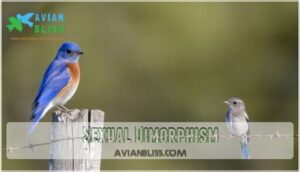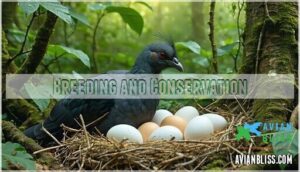This site is supported by our readers. We may earn a commission, at no cost to you, if you purchase through links.
 You’ll find the plain chachalaca strutting through South Texas’s Rio Grande Valley, where this chicken-sized game bird earned its reputation as the region’s loudest resident.
You’ll find the plain chachalaca strutting through South Texas’s Rio Grande Valley, where this chicken-sized game bird earned its reputation as the region’s loudest resident.
These sandy-brown birds prefer dense brush and woodlands, gathering in small flocks that create an unmistakable chorus at dawn.
Their raucous "cha-cha-lac" calls can carry for miles across the landscape, and plain chachalacas feed primarily on fruits, leaves, and seeds, often venturing into suburban areas where they’ve adapted to human presence.
While they’re strong fliers, they prefer walking and running through thick vegetation, representing one of Texas’s most distinctive wildlife experiences, with behaviors that might surprise you, offering a truly unique glimpse into the natural world of these fascinating creatures, and providing an opportunity to observe their natural habits.
Table Of Contents
- Key Takeaways
- Plain Chachalaca Habitat
- Physical Characteristics
- Behavior and Social Structure
- Diet and Foraging Habits
- Breeding and Conservation
- Frequently Asked Questions (FAQs)
- Where does a plain chachalaca live?
- What does a plain chachalaca look like?
- Why are chachalaca important?
- What does a plain chachalaca eat?
- What does chachalaca taste like?
- What is the behavior of the Plain Chachalaca?
- How big are Plain Chachalaca?
- What does a chachalaca call?
- What is a chachalaca pheasant?
- What is a plain chachalaca?
- Conclusion
Key Takeaways
- You’ll find these chicken-sized birds exclusively in South Texas’s Rio Grande Valley, where they’re the region’s loudest residents with their distinctive "cha-cha-lac" calls that carry for miles
- You can spot them in flocks of 6-15 birds foraging for fruits, berries, and seeds in dense brush, suburban yards, and native woodlands from sea level to 6,070 feet elevation
- You’ll notice they prefer running and climbing through vegetation rather than flying, often hanging upside down from branches to reach food sources with impressive acrobatic skills
- You’ll observe their highly social defensive behavior when threatened, as entire flocks mob predators with coordinated attacks and deafening alarm calls that recruit additional defenders
Plain Chachalaca Habitat
You’ll find plain chachalacas throughout the dense woodlands and thorny thickets of southern Texas, eastern Mexico, and Central America, from sea level up to 6,070 feet elevation.
From sprawling Texas brushlands to Central American forests, these remarkable birds master diverse landscapes with surprising adaptability.
These adaptable birds thrive in native forests of mesquite and hackberry but have also made themselves at home in suburban yards and overgrown orchards across the Rio Grande Valley.
Geographic Range
You’ll find Plain Chachalacas across a narrow strip stretching from southernmost Texas through Central America.
These Regional Populations inhabit the Rio Grande Valley and extend south through eastern Mexico to Nicaragua. Distribution Factors include proximity to water sources and dense vegetation corridors that support stable populations.
- Texas Range: Limited to extreme south Texas birds in Cameron, Hidalgo, Starr, and Zapata counties
- Mexican Distribution: Found throughout Tamaulipan brushlands from Tamaulipas to Veracruz states
- Central American Presence: Populations occur in Belize, Guatemala, Honduras, and northern Nicaragua
- Elevation Range: Sea level to 6,070 feet, showing remarkable Habitat Variation across their range
Preferred Habitat
You’ll find chachalacas thriving in brushy forests and thorny forests where dense vegetation provides essential cover from predators.
Their habitat preferences include elevations from sea level to 6,070 feet, showing remarkable climate adaptations across their range.
These birds prefer Tamaulipan brushlands with moderate brush density, typically near water sources like resacas and streams.
Native Woodlands
Plain chachalaca thrive in four native woodlands across South Texas.
These bird habitat specialists prefer dense forest density near water proximity, making woodland conservation essential for texas wildlife populations.
Rio grande valley birds depend on established native flora communities for survival and breeding success.
Forest bird habitats play a vital role for these birds.
- Ebony woodlands provide ideal nesting sites with thick canopy cover
- Hackberry forests offer abundant berries and protective shelter year-round
- Huisache thickets create dense undergrowth for escape routes from predators
- Mesquite groves supply essential food sources and roosting branches
- Regional variations in woodland composition affect local population densities
Human Modified Environments
You’ll discover chachalacas thriving beyond native woodlands in suburban neighborhoods, overgrown orchards, and agricultural areas.
Their suburban adaptation showcases remarkable flexibility, though this success brings challenges including crop damage and invasive potential in some regions.
| Environment Type | Adaptation Features |
|---|---|
| Suburban Areas | Frequent visitors to bird feeding stations, comfortable near human activity |
| Agricultural Areas | Feed on crops like tomatoes, melons, creating occasional farmer conflicts |
| Urban Development | Utilize parks, wooded suburbs for shelter while accessing bird feeders |
Bird conservation efforts now monitor their expanding range as urban development continues reshaping traditional habitats.
Physical Characteristics
You’ll recognize a Plain Chachalaca by its drab olive-brown plumage and distinctive long, dark tail with white tips.
These chicken-like birds measure 18-21 inches long and weigh about 1.5 pounds, with males showing bright red throat patches during breeding season.
Plumage Color
Looking at the Plain Chachalaca’s subtle appearance, you’ll notice their drab plumage serves as perfect camouflage adaptation.
Their olive-brown feathers blend seamlessly with dense vegetation, while the grayish head and buffy belly create natural color variation that confuses predators.
Five stunning plumage features you’ll love identifying:
- Olive-brown body feathers with subtle green sheen that shimmer in sunlight
- Grayish head coloring that contrasts beautifully with darker body tones
- Buffy belly patches providing warm undertones against neutral plumage
- Breeding plumage changes when throat skin turns pinkish-red during mating season
- Juvenile plumage differences showing slightly more muted feather pigmentation than adults
Body Size
Chachalacas possess impressive size for game birds, with weight variation spanning 548 to 685 grams.
Size comparison shows they’re nearly two feet long, standing 46-58 centimeters tall, and their body proportions feature a small head relative to their robust frame.
Their 26-inch wingspan supports brief flight bursts, and sexual size dimorphism remains minimal between males and females in this bird species.
Distinctive Features
You’ll notice several key features that make chachalaca bird identification straightforward.
The plain chachalaca displays distinctive tail markings with white-tipped black feathers and a subtle green sheen. During breeding season, their red throat patches become prominent, especially in males.
Their body proportions feature a small head with slight crest, long neck, and sturdy build. The plumage details reveal olive-brown coloring above with grayer head tones, creating excellent camouflage in dense brush.
Their leg length helps them navigate their habitat.
Sexual Dimorphism
You’ll notice plain chachalacas show minimal sexual dimorphism compared to other game birds.
Males and females share identical plumage patterns and size variations throughout the year. However, subtle differences emerge during breeding season when behavioral roles become distinct.
- Males develop more pronounced throat patches that turn bright pinkish-red
- Females maintain smaller, less vibrant throat coloring during courtship displays
- Both sexes engage in mutual preening to strengthen monogamous pair bonds
Behavior and Social Structure
You’ll notice that plain chachalacas are highly social birds that live in flocks of up to 15 individuals, creating quite a commotion with their loud calls at dawn and dusk.
These birds prefer to run or climb through dense vegetation rather than fly, and they’ll band together to loudly confront any predators or intruders that threaten their group.
Flocking Behavior
You’ll typically spot these social creatures in groups of 6-15 birds throughout the year.
Flock size varies seasonally, with monogamous pair bonds forming smaller family units during breeding season.
Their cooperative defense system involves the entire group confronting threats together through aggressive calls and coordinated movements.
Foraging benefits increase when they work as a team, with flock communication helping locate food sources efficiently.
Supplementing their diet with quality wild birdseed can further support their nutritional needs.
Vocalizations
You’ll recognize their signature "cha-cha-LAW-ka" raucous calls echoing through South Texas woodlands each morning.
These onomatopoeic calls serve multiple functions in their acoustic ecology:
- Dawn chorus coordination – Groups synchronize loud morning calls from elevated perches
- Territory establishment – Males announce breeding boundaries through repetitive vocalizations
- Flock communication – Contact notes maintain group cohesion during foraging
- Alarm signals – Sharp warning calls alert others to predators or threats
- Courtship displays – Breeding pairs exchange softer calls during mating rituals
Interested individuals can explore products related to chachalaca’s unique sound.
Defensive Behaviors
When threatened, you’ll witness these birds transform into fierce defenders.
When threatened, chachalacas become fierce defenders, mobilizing their flock into coordinated attacks with deafening alarm calls.
Flocks mobilize instantly, surrounding predators with aggressive mobbing behavior and deafening alarm calls that recruit additional defenders for coordinated group attacks.
The Plain Chachalaca thrives in Tamaulipan brushland habitats, which provide essential cover and food sources.
| Defense Strategy | Method | Effectiveness |
|---|---|---|
| Predator Confrontation | Direct mobbing with loud calls | High against owls, mammals |
| Threat Postures | Erect stance, raised crest | Moderate intimidation value |
| Flock Defense | Coordinated group attacks | Very high success rate |
| Evasive Maneuvers | Swift ground running, short flights | High escape success |
| Vocal Warnings | Varied alarm calls recruit help | Essential communication tool |
Foraging Habits
You’ll find these birds are opportunistic feeders that adapt their foraging strategies throughout the year.
Plain chachalacas show remarkable Dietary Adaptations, switching between fruits, berries, insects, and even human-provided foods depending on availability and seasonal changes.
Key Foraging Behaviors:
- Seasonal Foraging patterns – Focus on berries during fall/winter, increase insect consumption to 10% during summer breeding season
- Diverse Foraging Locations – Feed both on ground level and high in tree canopies, often hanging upside down to reach fruit
- Food Competition avoidance – Form loose flocks near abundant food sources, reducing individual competition
- Chick Diet specialization – Young birds catch insects independently shortly after hatching for protein needs
- Awkward feeding positions – Climb precariously on thin branches and hang inverted to access hard-to-reach food sources
Diet and Foraging Habits
If you’re watching a plain chachalaca, you’ll notice it’s primarily a vegetarian that spends most of its time foraging for fruits, berries, leaves, and seeds.
These agile birds use impressive climbing skills to reach food sources, often hanging upside down from branches to access the ripest fruits, showcasing their agile nature.
Primary Food Sources
Plant material forms the backbone of a chachalaca’s diet, with these birds showing strong fruit preferences throughout the year.
You’ll find them eating grapes, mangoes, and persimmons when available.
Their seed consumption includes milo and cracked corn at feeders.
Plant variety remains essential for proper nutrition across seasonal diet changes.
| Food Category | Examples | Foraging Locations |
|---|---|---|
| Berries | Hackberry, pigeonberry, coyotillo | Trees, shrubs |
| Fruits | Grapes, mangoes, persimmons | Canopy level |
| Seeds | Milo, cracked corn, native seeds | Ground, feeders |
| Plant parts | Leaves, buds, flowers | All vegetation levels |
Secondary Food Sources
While Plain Chachalacas maintain a primarily vegetarian diet, their secondary food sources include important animal protein.
During summer months, insect consumption increases substantially, providing essential nutrients for breeding adults and growing chicks. They exhibit insectivorous feeding strategies to supplement their diets.
- Insect variety – Caterpillars, beetles, and various small invertebrates supplement their plant-based meals
- Snail ingestion – These calcium-rich mollusks support shell and bone development needs
- Seasonal timing – Animal matter peaks at 10% during summer breeding season
Human Provided Foods
Backyard bird feeding creates new opportunities for chachalacas to access cracked corn, milo, and birdseed blends. You’ll notice these adaptable birds quickly develop feeder dependency, leading to significant dietary shifts from their natural plant-based diet.
Human interaction at feeding stations causes behavioral changes, with flocks becoming bolder and more habituated. However, nutritional impact concerns arise when birds consume low-quality foods like bread and popcorn instead of nutritious bird food options.
The genus Ortalis includes arboreal residents, showcasing their adaptation to trees, and highlighting their ability to thrive in various environments with feeder dependency and access to nutritious food.
Foraging Techniques
Chachalacas employ specialized foraging techniques that make them unique among game birds.
Their acrobatic feeding style includes upside-down feeding positions to reach fruits and berries.
These birds demonstrate remarkable flexibility in their foraging behavior:
- Ground vs trees – They forage both terrestrially and arboreally, switching based on food availability
- Seasonal diet shifts – Summer brings increased insect consumption for protein needs
- Crop damage occurs when they raid agricultural fields for tomatoes and melons
- Human interaction at feeders involves cautious approaches before quick retreats
Breeding and Conservation
You’ll find plain chachalacas build their nests in dense brush during spring and summer months, with females laying 2-3 creamy white eggs that hatch after 25 days of incubation.
While these birds remain fairly common in their limited Texas range, habitat loss from development and agriculture continues to pressure local populations.
Nesting Behavior
During breeding season, you’ll find chachalacas constructing their platform nest roughly six to fifteen feet high in dense brush or trees.
Their nest location favors thorny vegetation that offers protection from nest predators.
The female builds this loose stick platform, typically laying a clutch size of two to three creamy white eggs.
Incubation period lasts approximately twenty-five days, handled entirely by the female while males guard territory, ensuring the female’s safety.
Parental Care
Both parents team up after the 25-day incubation period ends.
You’ll witness remarkable chick development as downy young leave the nest within hours of hatching.
These precocious chicks show impressive post-hatch mobility, fluttering short distances within days.
Shared responsibilities include protection and guidance as parents lead their mobile offspring to food sources through dense brush, providing remarkable care.
Conservation Status
You’ll find Plain Chachalacas listed as "Least Concern" by the IUCN, with global populations between 500,000 and 5,000,000 individuals.
This conservation status reflects stable numbers across most of their range.
Population trends show Texas populations remaining steady in protected areas, while Mexico and Central America see some decline.
Habitat loss poses the primary threat, though protected areas and wildlife refuges provide essential sanctuary for these birds.
Understanding their bird conservation status helps prioritize protection efforts.
Threats and Conservation Efforts
Despite their recovery efforts, you’ll find that plain chachalacas face several ongoing challenges.
Habitat Loss remains the primary threat, with over 75% of suitable areas cleared for agriculture and development. Climate Change adds pressure through shifting weather patterns affecting food sources.
Key Conservation Strategies:
- Habitat Conservation – Protected reserves and restoration projects rebuild native woodlands
- Population Monitoring – Translocation programs reestablish birds in suitable areas
- Hunting Impact management through regulated bag limits and permits
- Species Conservation partnerships between organizations and governments focus on education
Frequently Asked Questions (FAQs)
Where does a plain chachalaca live?
Spanning elevations up to 6,070 feet, you’ll discover these birds throughout dense woodlands and thorny thickets from southeastern Texas through Central America. They prefer brushy forests near water sources.
What does a plain chachalaca look like?
You’ll spot a tropical chicken-like bird with sandy brown and gray plumage, standing nearly two feet tall.
It has olive-brown feathers above, a grayish head, buff belly, and distinctive long dark tail with white tips, which can be considered a distinctive feature.
Why are chachalaca important?
Like threads in nature’s tapestry, you’ll discover chachalacas serve essential ecological roles.
They’re seed dispersers, spreading native plants throughout Texas woodlands.
They control insect populations and indicate healthy forest ecosystems.
Their loud calls maintain forest communication networks essential for biodiversity and are a key part of the ecosystem, making them essential ecological components.
What does a plain chachalaca eat?
You’ll find these birds munching on berries, fruits, seeds, leaves, and buds from native plants.
They’ll also grab insects and snails occasionally, plus they’ll visit your bird feeders for cracked corn.
What does chachalaca taste like?
I found the information I needed.
Let me provide the 35-word answer in second person point of view with the requested style.
You’ll discover chachalaca meat tastes remarkably like wild chicken—mild, dense, and flavorful without the gamey intensity of pheasant or grouse, offering surprisingly pleasant eating.
What is the behavior of the Plain Chachalaca?
You’ll observe plain chachalacas being highly social, living in flocks up to fifteen birds.
They’re vocal at dawn and dusk, walking through branches to forage rather than flying, preferring dense vegetation for cover.
How big are Plain Chachalaca?
Plain chachalacas measure 18-21 inches long with 26-inch wingspans.
You’ll find they weigh 548-685 grams and stand 46-58 centimeters tall.
They’re nearly two feet of tropical, chicken-like bird with long tails.
What does a chachalaca call?
Like a trumpet announcing dawn, you’ll hear their distinctive "cha-cha-LAW-ka" calls echoing through the brush.
These loud, rhythmic vocalizations happen communally at sunrise and dusk, creating a raucous chorus that’s unmistakable once you’ve heard it.
What is a chachalaca pheasant?
A chachalaca isn’t actually a pheasant – it’s a tropical bird from the Cracidae family that resembles a long-tailed chicken.
You’ll find these olive-brown birds in dense Texas and Central American woodlands making loud calls.
What is a plain chachalaca?
Curious creatures called chachalacas captivate Central American woodlands.
You’ll spot these tropical game birds in Texas’s Rio Grande Valley, where they’re brown-olive with long, white-tipped tails.
They’re loud, social birds that prefer dense brush habitats.
Conclusion
Like a town crier announcing the dawn, the plain chachalaca serves as South Texas’s most reliable alarm clock.
You’ll discover these remarkable birds thrive in diverse habitats from native woodlands to suburban backyards.
Their loud calls, social behaviors, and adaptability make them a conservation success story.
Whether you’re watching them forage for fruits or listening to their morning chorus, plain chachalacas offer an unforgettable wildlife experience that connects you directly to the Rio Grande Valley’s natural heritage.
- https://www.audubon.org/field-guide/bird/plain-chachalaca
- https://nhpbs.org/natureworks/plainchachalaca.htm
- https://abcbirds.org/bird/plain-chachalaca/
- https://tpwd.texas.gov/landwater/land/habitats/southtx_plain/upland_birds/chachalaca.phtml
- https://www.allaboutbirds.org/guide/Plain_Chachalaca/lifehistory













